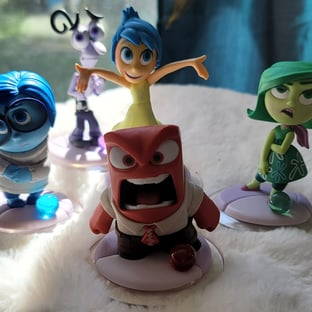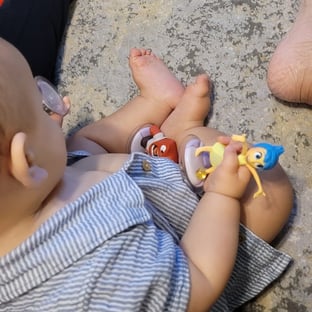Why I do what I do and how!
I didn't always want to be a therapist.
RELATIONSHIPS
Michelle R. Lopez, LCSW, CST
7/9/20233 min read
There have been a ton of changes in our family in the last year. We added a new baby and we bought a house and moved.
During the move, many long forgotten things reemerged and these little figurines were among them! If you don't recognize them, they are Disney Infinity figures that allow you to play the Inside Out characters inside the Infinity virtual world. I honestly couldn't tell you when they were purchased or even used but I thought, "Why not dust these cuties off and put them front and center in my office since they represent emotions?"
Well, my son had different plans apparently. When he saw them, they absolutely tickled him and he has played with them almost every day since.


Out of curiosity, I wondered what he would think of the film. So I turned it on and naturally, thanks to the bright colors and light music, he was very entertained by it. Of course he can't understand it, he's only 10 months old but as he fell asleep, I continued to watch it and I remembered the first time I saw this movie.
It was 2015 and I was just starting the second year of my master's program in Social Work. I feel like I consumed the movie in a vastly different way than most other folks as it demonstrated the complexities of the human psyche in a way that was much more fun than the lectures and textbooks at school. It would be at least 2 years before I began supervision for licensure and the words "Internal Family Systems" would change my approach to counseling forever.
The film Inside Out is a brilliant representation of the Internal Family Systems (IFS) model of therapy. The emotions displayed in the movie are parts of the main character's psyche that have unique roles and functions. This aligns with IFS, which views the psyche as composed of parts or sub-personalities, each with its own story, fears, and beliefs. Five key emotions - joy, sadness, anger, disgust, and fear - are portrayed as parts that help the protagonist navigate her world. By showing how these parts interact and collaborate, Inside Out offers a fascinating portrayal of how the psyche works according to this model.
Why did I find this model so alluring? For one, it aligns very neatly with Narrative Therapy. Both narrative therapy and IFS rely on an individual engaging what modern psychology would call active imagination, the ability to have a very present and creative imagination. One that is capable of seeing previous knowledge and experiences, to be aware of it, and to permit the evolution of the story that knowledge and experience tells, to be capable of shifting the meaning behind experiences. Both are typically a collaborative and non-judgmental process that enables individuals to make meaning of their lives and find new ways to move forward.
Both the IFS model and Narrative Therapy also rely on externalizing that which is considered problematic. Ideally, they help someone come to the conclusion of, "I'm not the problem. The problem is the problem." Externalizing involves separating the problem from the person's identity by giving it a name, symbol or character. This allows the person to view the problem as something separate from themselves, reducing the shame and blame they feel about it. By externalizing the issue, it also becomes easier to examine it objectively and find new ways to address it. Narrative therapy uses language as a tool to help individuals construct meaningful and positive stories about their lives. In IFS, clients are taught to view their "problematic" parts as separate from themselves but also to eventually help those same parts find new roles that won't be as problematic in the future. Both models focus on transforming negative self-perceptions into empowering beliefs and behaviors.
And to think, when I graduated high school I wanted to be a mathematician. I hate math.
These two modalities have helped numerous clients destigmatize their histories. Individuals who have lived with diagnoses ranging from Bipolar disorder to generalized anxiety have benefited from becoming aware of the narratives they keep and the parts that make up their system. Both modalities help me conceptualize their goals, strengths, and barriers and it gives us a language to use to talk about them from a position of compassion and curiosity.
If you would like to learning more about Internal Family Systems or Narrative Therapy, head on over to the resource library where I have uploaded links to videos and handouts that can help provide more information. And if you think this approach can help you, please feel free to reach out or find a provider in your area that operates from this perspective as well!
My office
Telehealth &
In-office (TBD)
Contacts
michellelopez.lcsw@outlook.com
407.720.9789